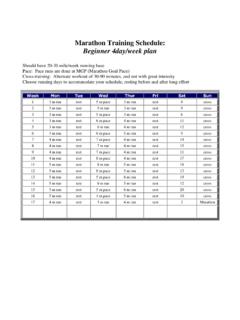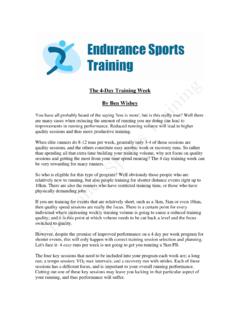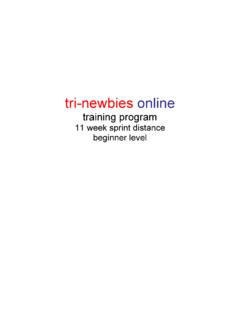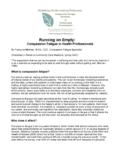Transcription of Maintaining High Turnover When Running Slowly
1 Evolution Running 1 Maintaining high Turnover when Running Slowly by Ken Mierke Running with high Turnover (180-182 foot-strikes per minute) increases Running efficiency and reduces the risk of injury. Many runners maintain high Turnover during tempo runs, track workouts, and races, but fail to do so when Running at a basic endurance pace. Learning to maintain the same Turnover when Running at any speed will improve your training and racing. Elite runners of any height and leg length, generally run with a cadence between 180 and 182 steps per minute. Watch the lead pack in a road race the next time you get the opportunity.
2 You will be amazed at the incredible synchronicity of the runner s strides. Efficient runners of significantly different height and leg length consistently chose almost identical Turnover rates. Why would a 6 2 professional runner use the same Turnover rate and significantly shorter stride length (proportionate to height) than a 5 4 runner? One major reason for this is caused by the nature of the elastic responses of human tissue. At a given pace, longer strides mean more contact time with the ground. This reduces the benefit of elastic recoil, causing the muscles to contract more forcefully. Even though a taller runner s legs may be longer, his elastic tissues respond just like shorter runners.
3 when human tissue is stretched and released, it snaps back forcefully. This enables runners to store energy in the Plantar Fascia, the Achilles tendon, and the Soleus and Gastrocnemius muscles from one stride and return that energy as propulsion in the next stride. Optimal use of elastic recoil is a major difference in efficiency differences between runners. Runners tissues snap back forcefully when stretched and released, but they do not when stretched and held, even for a very short time period. when the stretch is held, even for a fraction of a second, the stored energy dissipates, resulting in far less energy returned as elastic recoil.
4 The taller runner must take strides that are proportionally shorter (compared to leg length) in order to keep contact time between the feet and ground short to enable the energy return from elastic recoil. The second reason is that a longer stride necessitates greater vertical displacement. If I wanted to throw a baseball 20 feet, I could basically throw it on a straight line without much arc. To throw the ball 50 yards, however, I would have to arc it upward, because gravity would have a long time to act on the ball. In the same way, Running with long strides forces runners to move up and down more than shorter strides.
5 Longer strides also require the muscles to contract more forcefully to create horizontal propulsion. First of all, to cover 20% more ground, even with optimal efficiency, 20% more force at push-off would be required. Factoring in the need for vertical displacement and the loss of power from elastic recoil, and the increase in force required at push-off is staggering. Evolution Running 2 Contracting muscles more forcefully fatigues them far more than contracting them frequently with less force. Each of our muscles is made up of thousands of different muscle fibers. These muscle fibers fall into two basic categories (though there are also several sub-categories), slow-twitch and fast-twitch.
6 Fast-twitch fibers are tremendously powerful, but fatigue very quickly. Slow twitch muscle fibers have tremendous endurance, but are not very powerful. One major problem with taking long strides is that the slow-twitch fibers are not able to provide the majority of the power required for push-off and the fast-twitch fibers are required to contribute significantly. Running with longer strides and slower Turnover requires much more power at push-off than the slow-twitch fibers can produce. This means the fast-twitch, sprint muscle fibers must contract to make up the difference, which leads to lactic acid accumulation and premature fatigue.
7 Running with a slow Turnover requires increased vertical displacement, greater contact time with the ground, and more forceful contractions at push-off, all of which impair economy and lead to local muscular fatigue and greater risk of injuries. Improving this aspect of technique pays big dividends. Our research has shown that, for durations of the range of triathlon race durations, optimal Turnover is about 180 182 steps per minute, regardless of Running speed. This is considerably higher Turnover than most runners naturally use, especially on long, slow runs. Learning to keep Turnover higher on your easy runs is a critical part of efficient training.
8 Good cyclists keep cadence relatively high even on an easy zone 1-2 ride. Keeping Turnover high on easy runs is even more important because slow Turnover training does not effectively train the elastic response that you need to run your best on race day. If a runner uses slow Turnover for basic endurance training, he/she is asking his/her muscles to create force on race day in a way that has been trained for a small fraction of training mileage. That is not the way to produce optimal results. Running with quick, short strides is unnatural for all runners, but especially for taller runners, who have been told to take advantage of their long legs by using a long strides.
9 To gain the free speed of elastic recoil, tall runners must use the same high Turnover as shorter runners. This means they must learn to use steps which seem proportionally shorter for their leg length. I have had tremendous success teaching tall runners to take quick, short strides and increase their efficiency. My wife, who is 6 feet tall, learned to run with high Turnover and as a result won a triathlon national championship, turning in the fastest run split. Certain biomechanical techniques are key to increasing Turnover to maximize efficiency. 1. Efficient runners have no pause at the completion of the leg s follow through.
10 The leg pulls back to provide propulsion and then immediately the knee drives forward. Leg recovery must be initiated as the leg is still moving backward in follow through from the propulsive phase. 2. During leg recovery, the knee is driven forward powerfully by the hip flexor muscles at the front of the upper thigh. The forward movement must be quick and powerful, with full knee bend, Evolution Running 3 but the range of motion of leg recovery must be very short. The forward knee drive is completed when the knee is only slightly in front of the hip and the foot is directly beneath the knee. 3.







